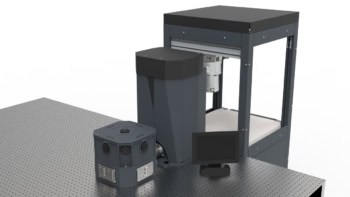
A new way of beating the diffraction limit in optical microscopy has been unveiled by physicists in Australia and China. The technique makes use of nanoparticles to improve the efficiency of stimulated emission depletion (STED) microscopy, allowing it to be used with lower levels of illumination than previously possible.
STED microscopy was developed by the Germany-based physicist Stefan Hell, who won one third of the 2014 Nobel Prize for Chemistry for his work on the technique. The technique allows features much smaller than the wavelength of light to be observed with a microscope – something that is impossible with conventional microscopes.
Doughnut’s hole
STED involves tagging regions of interest in a sample with fluorescent molecules and using a beam of light to cause the molecules to emit light. A second “depletion” beam of light is focused to a doughnut shape in the sample and suppresses the fluorescence everywhere in the focal region – except at the doughnut’s central hole. By scanning the beams jointly over the sample, the spatial distribution of the fluorescent molecules can be determined at resolutions much smaller than the wavelength of the light used.
The resolution of STED improves as the intensity of the depletion beam increases. However, if the depletion beam is too powerful it will heat up the sample and destroy it – and this puts a practical limit on the resolution that can be achieved.
Now, Peng Xi, Dayong Jin and colleagues at Macquarie University and several other institutes in Australia and China have got around this problem by using lanthanide-doped upconversion nanoparticles (UCNPs) in place of fluorescent molecules. UCNPs are tiny crystals – as small as 13 nm across in this particular study – that absorb two or more long-wavelength optical photons and then emit one shorter wavelength photon.
Blue light
When illuminated with near-infrared light at 980 nm, the team’s UCNPs emit blue light at 455 nm. However, when a near-infrared depletion beam at 808 nm is also fired at the nanocrystals, a stimulated emission process causes the UCNPs to stop emitting blue light and emit near-infrared light instead.
To see if the UCNPs are appropriate for STED, the nanocrystals were dispersed in a medium that was specifically formulated for fluorescence microscopy. The team then used STED to image the UCNPs at a spatial resolution of about 28 nm, which is much shorter than the wavelengths of the light used by the microscope. To achieve similar resolution using traditional STED techniques would require a much more intense depletion beam, say the researchers. Another benefit of using the UCNPs is that the near-infrared light can be supplied by two simple diode lasers.
However, the technique does have some downsides. The intensity of blue light given off by the UCNPs is much lower than the light produced in conventional STED, which means that it takes about 10 times longer to acquire an image. Further work must also be done to ensure that the nanoparticles will only tag specific regions of a sample. The researchers must also ensure that the UCNPs do not stick together when dispersed in a sample.
The technique is described in Nature.



